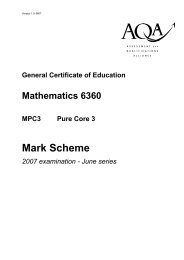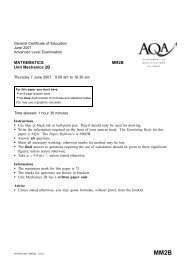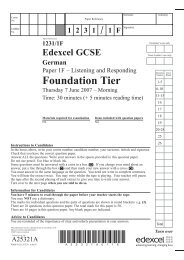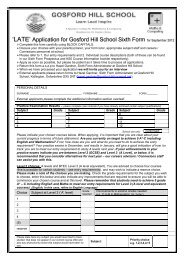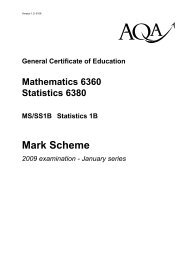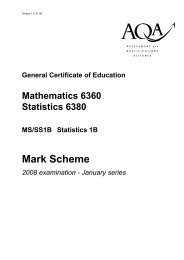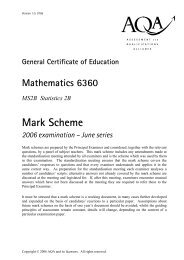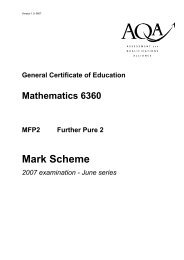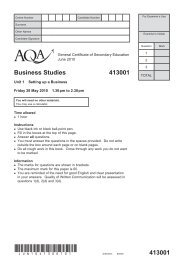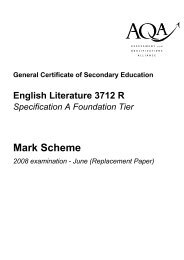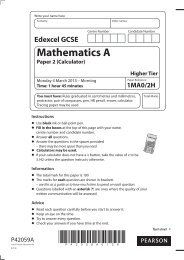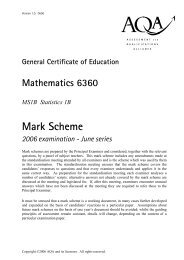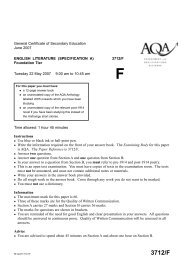GCE Mathematics Written Mark Scheme January 2006 - Gosford Hill ...
GCE Mathematics Written Mark Scheme January 2006 - Gosford Hill ...
GCE Mathematics Written Mark Scheme January 2006 - Gosford Hill ...
Create successful ePaper yourself
Turn your PDF publications into a flip-book with our unique Google optimized e-Paper software.
Version 1.0: 0106General Certificate of Educationabc<strong>Mathematics</strong> 6360MPC4 Pure Core 4<strong>Mark</strong> <strong>Scheme</strong><strong>2006</strong> examination - <strong>January</strong> series<strong>Mark</strong> schemes are prepared by the Principal Examiner and considered, together with the relevantquestions, by a panel of subject teachers. This mark scheme includes any amendments made atthe standardisation meeting attended by all examiners and is the scheme which was used by themin this examination. The standardisation meeting ensures that the mark scheme covers thecandidates’ responses to questions and that every examiner understands and applies it in thesame correct way. As preparation for the standardisation meeting each examiner analyses anumber of candidates’ scripts: alternative answers not already covered by the mark scheme arediscussed at the meeting and legislated for. If, after this meeting, examiners encounter unusualanswers which have not been discussed at the meeting they are required to refer these to thePrincipal Examiner.It must be stressed that a mark scheme is a working document, in many cases further developedand expanded on the basis of candidates’ reactions to a particular paper. Assumptions aboutfuture mark schemes on the basis of one year’s document should be avoided; whilst the guidingprinciples of assessment remain constant, details will change, depending on the content of aparticular examination paper.Copyright © <strong>2006</strong> AQA and its licensors. All rights reserved.
MPC4 – AQA <strong>GCE</strong> <strong>Mark</strong> <strong>Scheme</strong>, <strong>2006</strong> <strong>January</strong> seriesKey To <strong>Mark</strong> <strong>Scheme</strong> And Abbreviations Used In <strong>Mark</strong>ingMm or dMABEmark is for methodmark is dependent on one or more M marks and is for methodmark is dependent on M or m marks and is for accuracymark is independent of M or m marks and is for method and accuracymark is for explanationor ft or F follow through from previousincorrect result MC mis-copyCAO correct answer only MR mis-readCSO correct solution only RA required accuracyAWFW anything which falls within FW further workAWRT anything which rounds to ISW ignore subsequent workACF any correct form FIW from incorrect workAG answer given BOD given benefit of doubtSC special case WR work replaced by candidateOE or equivalent FB formulae bookA2,1 2 or 1 (or 0) accuracy marks NOS not on scheme–x EE deduct x marks for each error G graphNMS no method shown c candidatePI possibly implied sf significant figure(s)SCA substantially correct approach dp decimal place(s)No Method ShownWhere the question specifically requires a particular method to be used, we must usually see evidence ofuse of this method for any marks to be awarded. However, there are situations in some units where partmarks would be appropriate, particularly when similar techniques are involved. Your Principal Examinerwill alert you to these and details will be provided on the mark scheme.Where the answer can be reasonably obtained without showing working and it is very unlikely that thecorrect answer can be obtained by using an incorrect method, we must award full marks. However, theobvious penalty to candidates showing no working is that incorrect answers, however close, earn nomarks.Where a question asks the candidate to state or write down a result, no method need be shown for fullmarks.Where the permitted calculator has functions which reasonably allow the solution of the question directly,the correct answer without working earns full marks, unless it is given to less than the degree of accuracyaccepted in the mark scheme, when it gains no marks.Otherwise we require evidence of a correct method for any marks to be awarded.2
AQA <strong>GCE</strong> <strong>Mark</strong> <strong>Scheme</strong>, <strong>2006</strong> <strong>January</strong> series – MPC4Q Solution <strong>Mark</strong>s Total Comments1(a)(i) f (1) = 0 B1 1(ii) f (– 2) = – 24 + 8 + 14 + 2 = 0 B1 1(iii) ( x− 1)( x+ 2) ( x− 1)( x+2)=3 23x + 2x − 7x+2 ( x − 1)( x+ 2)( ax+b)B1Recognising ( x –1),( x+ 2)as factorsPI3 3ax = 3 x – 2b= 2a= 3 b=–1B1B13abOr By division M1 attempt startedM1 complete divisionA1 Correct answers(b) Use 1 32(a)(b)3 2⎛1⎞ ⎛1⎞13⎜ ⎟ + 2⎜ ⎟ − 7× + d = 2⎝3⎠ ⎝3⎠3B1M1d = 4 A1F 3Total 8dy−2 dx= =− 42dt t dtM1A1dydy1 1= ⋅ = m1d2dx dt x 2tA1F 4dtt = 21mT=8x=− 5 y = 2B11y− 2= + 58x 8y21 0( x )Remainder Th with ± ± 33,M 1Ft on – 1⎛43 answer – ⎞⎜ ⎟⎝ 9⎠Or by division M1 M1 A1 as aboveUse chain ruleFollow on use of chain rule ( if f () t )Or eliminate t: M1 y=f ( x)attempt todifferentiate M1A1chain ruleA1F reintroduce tB1F follow on gradient ( possibly used later )M1Their ( x y)− + = A1F 4 Ft on ( x y ), , m, and m(c) 2x− 3 =− 4 t y – 1 = M1 PIt2( x−3)( y− 1) =− 4t× = ( − 8)M1Attempt to eliminate ttA1 3 AG convincingly obtainedTotal 113
MPC4 – AQA <strong>GCE</strong> <strong>Mark</strong> <strong>Scheme</strong>, <strong>2006</strong> <strong>January</strong> seriesMPC4 (cont)Q Solution <strong>Mark</strong>s Total Comments3(a) R = 13 Or 3.6B1 1(b)sinα2tan α α 33.7cosα 3–2 3Allow M1 for tan α = or ±3 2AG convincingly obtained(c) maximum value = 13B1Fcos ( θ + 33.7) = 1 ( θ = –33.7)M1θ = 326.3A1 3 AWRT 326Total 64(a) A = 80B1 1(b)5000 80 k56= × M1 SC1 Verification. Need 62.51 or betterk = 5000 56 ≈ 1.0766480M1A1 3⎧⎨⎩⎛5000⎞Or using logs: M1 ln ⎜ ⎟ = 56 ln k⎝ 80 ⎠⎛62.5⎞ln⎜⎟⎝ 56 ⎠A1 k = eOr 3/3 for k = 1.076636Or 1.076637 seen106(c)(i) V = 80× k = 200707M1A1 2 <strong>2006</strong>48 using full register k(ii) ln10000 = ln ktM1ln10000t = 124.7 2024ln k= ⇒ M1A1 3 M1 t ln k = ln 10000A1 CAOOr trial and improvement M1expressionM1 125, 124, A1 2024Total 9−1 ( −1)( −2)21− x = 1+ −1 ( − x) + ( − x)M1 First two terms + kx222= 1+ x + xA1 25(a)(i) ( ) ( )(ii)( x)−11 1⎛213 2 3 3 x ⎞= ⎜ − ⎟B1− ⎝ ⎠Or directly substitute into formula;2⎛ 2 2 ⎞M1 power of 3⎛ ⎞≈ * 1+ x+⎜ x⎜⎟3 ⎝ 3 ⎠ ⎟M1M1 other coefficients (allow one error)⎝⎠A1 CAO1 2 4 2≈ + x + xA1 3 AG convincingly obtained3 9 27(b) ( 1 x) 1 ( 2)( x)( )( )( x) 2−2 −2 −3−− = + − − +22= 1+ 2x+ 3xM1A1 2First two terms +2kx4
AQA <strong>GCE</strong> <strong>Mark</strong> <strong>Scheme</strong>, <strong>2006</strong> <strong>January</strong> series – MPC4MPC4 (Cont)Q Solution <strong>Mark</strong>s Total Comments5(c)22x − 3=2A 1− x + B 3−2x 1− x + C 3− 2xM1 Or by equating coefficients(d)6(a)( ) ( )( ) ( )3 3 1x= 1 –1 = C× 1 x= = A×2 2 4C =− 1 A= 6A1 Follow on A and Cx= 0 − 3 = 6 + 3B−3( )M1or other value ⇒ equation in A, B, C m1B =− 2A1 56 2 1− −3−2x 1−x 1−x( ) 2( )M1 sameA1 collect termsM1 equate coefficientsA1 2 correctA1 3 correct6⎛2 4 2⎞2≈ 1 x x 2 1 x x3⎜ + + − + +3 9⎟⎝⎠M1A1F Follow on A B C and expansions2 8 37 2− ( 1+ 2x + 3 x ) ≈−1− x−x 3 9A1 3 CAOTotal 152cos 2x= 2cos x − 1B1B1 2(b)7(a)(i)cos x= (cos 2x+1)2π22 11 ⎡1x ⎤cos 2 1 d sin 22∫x+ x= ⎢ x+4 2⎥0⎣ ⎦π=4⎡6⎤ ⎡2⎤ ⎡4⎤!!!"AB =⎢5⎥ ⎢1⎥ ⎢4⎥⎢ ⎥−⎢ ⎥=⎢ ⎥⎢⎣3⎥⎦ ⎢⎣3⎥⎦ ⎢⎣0⎥⎦π20M1A1A1Attempt to expresscos 2x2cos x in terms ofM1A1F 5 Use limits. Ft on integer a.Total 7Penalise use of co-ordinates at firstM1occurrence onlyA1 2(ii) ⎡4⎤⎡1⎤⎢4⎥4⎢1⎥⎢ ⎥=⎢ ⎥⇒ parallel⎢⎣0⎥⎦⎢⎣0⎥⎦E1 1Needs comment “same direction”Or “same gradient”Or by scalar product( )(iii) ⎡ 2⎤ ⎡ 6⎤ ⎡1⎤⎢3⎥ ⎢1⎥λ⎢1⎥⎢−⎥=⎢ ⎥+⎢ ⎥M1⎢⎣−1⎥⎦ ⎢⎣−1⎥⎦ ⎢⎣0⎥⎦is satisfied by λ =− 4A1 2 λ = – 4satisfies 2equations5
MPC4 – AQA <strong>GCE</strong> <strong>Mark</strong> <strong>Scheme</strong>, <strong>2006</strong> <strong>January</strong> seriesMPC4 (cont)Q Solution <strong>Mark</strong>s Total Comments(b)(i) l 2 has equationOr⎡4⎤ ⎡⎡4⎤ ⎡ 2⎤⎤⎡4⎤ ⎡2⎤M1A1 2 ⎡ 2 ⎤ ⎡2⎤⎢ ⎥r =⎢1⎥+ λ⎢1⎥−⎢− 3⎥=⎢1⎥+ λ⎢4⎥⎢ ⎥ ⎢⎢ ⎥ ⎢ ⎥⎥r =⎢–3⎥t⎢4⎥⎢ ⎥ ⎢ ⎥⎢ ⎥+⎢ ⎥M1 calculate and use⎢⎣1⎥⎦ ⎢⎣⎢⎣1⎥⎦ ⎢⎣−1⎥⎦ ⎥⎦⎢⎣1⎥⎦ ⎢⎣2⎥⎦⎢⎣ –1⎥⎦ ⎢⎣2⎥⎦direction vector A1 all correct(ii) ⎡1⎤ ⎡ 4⎤⎢2⎥ ⎢0⎥⎢ ⎥•⎢ ⎥= 4− 4=0⎢⎣1⎥⎦ ⎢⎣−4⎥⎦8(a)M1A1⇒ 90° ( or perpendicular )A1F 3∫dxdx= ∫−2dtx − 6Total 10M1Clear attempt to use directions of AC andl 2 in scalar productAccept a correct ft value of cosθAttempt to separate and integrate2 x − 6 = − 2t+ cA1A1 c on either sidet = 0 x=70 ⇒ c = 16m1A1F Follow on c from sensible attempt atintegrals ( not ln )t = 8− x− 6A1 6 CAO ( or AEF )(b)(i) The liquid level stops falling/flowing/ B1 1at minimum depthx= 22 t = 8 – 22 – 6M1 Use x = 22 in their equation providedthere is a cOr start again using limitsM1 2 64 – 2 16 =± 2 t, A1 t = 4t = 4 A1 2 CAOTotal 9Total 756



